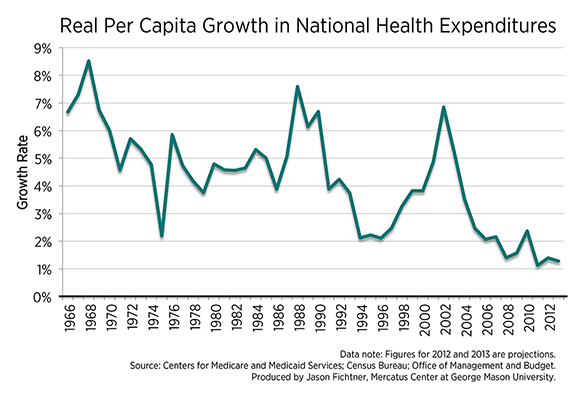- | Government Spending Government Spending
- | Data Visualizations Data Visualizations
- |
Uncertainty Over Growth in Health Care Costs
This chart uses data from the Centers for Medicare and Medicaid Services (CMS) to show the growth in national health expenditures (NHE) after adjusting for inflation and population. The data show an up-and-down trend, leading to uncertainty over the growth in national health expenditures.

President Obama’s Council of Economic Advisers released a report near the end of 2013 suggesting that the Affordable Care Act (ACA) was responsible for the recent reduction in health care cost growth and will ultimately lead to further reductions in health care costs. Whether the recent decline in the growth rate of health care costs is a permanent trend or an aberration that will abate is a question worth considering.

This chart uses data from the Centers for Medicare and Medicaid Services (CMS) to show the growth in national health expenditures (NHE) after adjusting for inflation and population. The data show an up-and-down trend, leading to uncertainty over the growth in national health expenditures.
Between 1996 and 2002, NHE continued to grow at a faster rate each year—from about two percent to seven percent. In 2002, NHE spending per capita rose by nearly seven percent and then began to slow over the ensuing years. In 2008, NHE spending per capita rose just 1.5 percent—two years before the ACA was enacted.
The claims from the Obama administration that the ACA was responsible for the decline in the cost growth of health care were quickly disputed by several health care experts, including Charles Blahous, a public trustee for Social Security and Medicaid who wrote that the chief actuary for CMS “found that the ACA would increase national health expenditures through 2016” (See Charles Blahous, “No Grounds for Claim that Obamacare Lowers Healthcare Costs,” at e21, November 25, 2013).
Data Note: Health care expenditures data from the Centers for Medicare and Medicaid Services, population data from the Census Bureau, and 2005 inflation-adjustment figures from the Office of Management and Budget’s historical tables.

